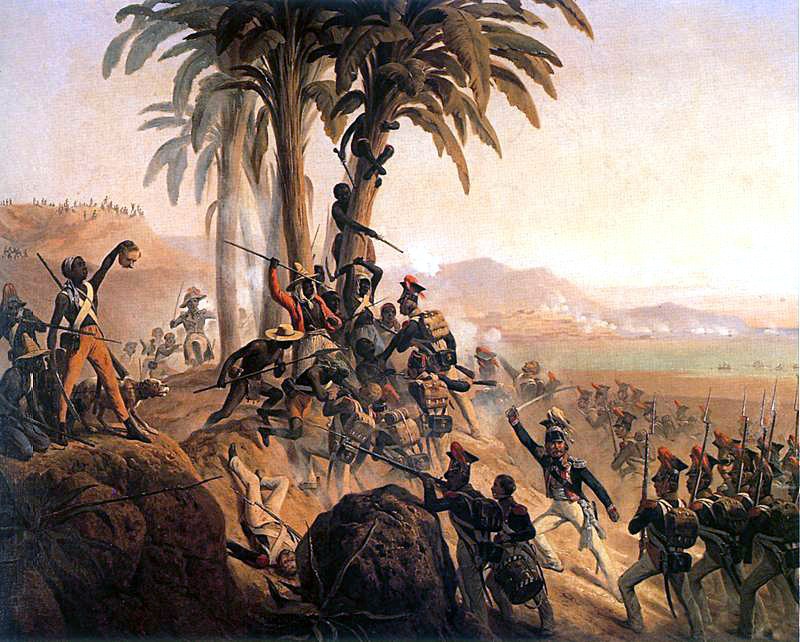The success of the American and the French Revolutions echoed through the people of the new and the old world. These events, powered by the Enlightenment ideas of popular sovereignty, individual freedom, and equality, proved that parting from powerful and oppressive rulers was possible.1 For the first time in recent history, the common man had united and fought for a republic based on the idea and practice of self-rule. This idea of fighting and revolting for independence traveled to slaves on the shores of a Caribbean island where the French had established the colony of Saint-Domingue in 1697.

Saint-Domingue was perhaps one of the most profitable lands that France had in its possession since it produced and exported coffee, indigo, tobacco, cotton, and sugar. The original aboriginal population of the islands had all but disappeared by the time the French had come to the island, and to make use of the colony, the French began to import slaves from Africa to work the fields. It is estimated that by 1789, the colony had a total of 500,000 African slaves, 35,000 white French settlers, and 50,000 colored freedmen who were French citizens and who also owned slaves.2 Despite slaves being the majority of the colony’s population, they lived under a strict and abusive social structure where they worked strenuous jobs under the threat of the whip, and would often starve to death. If runaway slaves were caught, they were often tortured and mutilated in order to dissuade other slaves that there was no escape from the chains of slavery. The daily life for the slaves of Saint-Domingue was one of fear and ill treatment.

French King Louis XIV established the “Code Noir” or Black Codes for the colony, which established rules for the treatment of slaves in all of its French American colonies. The code stated that slave owners were prohibited from sexually violating slaves or from torturing them, and they were required to provide food and clothes to the slaves. Nevertheless, slaves were regarded as property and could receive the death penalty if they did not comply with their masters.3
In 1788, fourteen slaves complained to the court that Nicolas Lejuene, a slave master’s son, would burn slaves alive, and although these acts were clearly violating the law, the courts and public opinion on the Island dismissed Lejuene and he was not prosecuted.4 This incident suggests that laws were not uniformly enforced in the colony, so masters had a free hand in their often atrocious treatments of their slaves. Many slaves ran away from their oppressive masters and hid in the mountains forming large communities of maroons. Their resentment to their French masters only escalated.5

With the ideas of political independence and social revolution circulating the world, slaves in the colony of Saint-Domingue were no longer willing to endure the treatment of their French masters. Tensions in the colony led to a violent uprising. The Haitian Revolution began in August 1791, when about 15,000 slaves destroyed and burned plantations and homes, and murdered white settlers in what was called the “Night of Fire.”6 This event encouraged the educated Catholic and former slave Toussaint L’Ouverture to join the cause. He helped train an army of 50,000 slaves in guerrilla warfare.7 The colony fell into chaos for years as the slaves revolted against French oppression in violent measures, and it was not long before the colony of Saint-Domingue was controlled by the slaves of the island.8

General L’Ouverture allied with the British in order to drive out the French settlers. But unwilling to let go of their colonial power, the French emancipated slaves in 1794; but they were still unable to secure and control the Haitian revolt. By 1803, L’Ouverture had proclaimed himself the governor of the colony, angering the powerful Napoleon Bonaparte who went after L’Ouverture, capturing and imprisoning him. This, however, did not weaken the resolve of the slaves to form an independent state. As Jean-Jacques Dessalines rose to power in the absence of Toussaint L’Ouverture, he ordered the gruesome execution of all Frenchmen in the colony. A year later, in 1804, Haiti was declared independent from French power.9
The slaves of Saint-Domingue were not expected to take on the example of the American colonies and the Enlightenment Era in order to fight for their independence. After the gory and terrible deaths of almost half the population in the colony–including French settlers, free black men and slaves–Haiti stood tall and free, shocking the world.10
- Jerry H. Bentley, Herbert F. Ziegler and Heather E. Streets-Salter, Traditions and Encounters: A Brief Global History Vol 2 (New York: MacGraw-Hill Education, 2016), 471. ↵
- Encyclopedia of Emancipation and Abolition in the Transatlantic World, 2007, s.v. “Haitian Revolution,” by Eugenio Matibag and Junius Rodriguez. ↵
- Philippe R. Girard, “Code Noir,” in Africa and the Americas: Culture, Politics, and History, no.1 (2008): 1. ↵
- Laurie M. Wood, “Across Oceans and Revolutions: Law and Slavery in French Saint-Domingue and Beyond,” Law & Social Inquiry 39, no. 3 (Summer 2014): 5. ↵
- Jerry H. Bentley, Herbert F. Ziegler and Heather E. Streets-Salter, Traditions and Encounters: A Brief Global History Vol 2 (New York: McGraw-Hill Education, 2016), 478-479. ↵
- The Black Past: Remembered and Reclaimed, 2007, s.v. “L’Ouverture Toussaint (1742-1803),” by Deborah McNally. ↵
- J. R. Beard, The Life of Toussaint L’Ouverture, the Negro Patriot of Hayti: Comprising an Account of the Struggle for Liberty in the Island, and a Sketch of Its History to the Present Period (Chapel Hill: University of North Carolina at Chapel Hill Library, 2012), 54. ↵
- Matt Clavin, “Race, Rebellion, and the Gothic: Inventing the Haitian Revolution,” Early American Studies, no. 1 (2007): 5. ↵
- Matt Clavin, “Race, Rebellion, and the Gothic: Inventing the Haitian Revolution.” Early American Studies, no. 1 (2007): 2. ↵
- Matt Clavin “Race, Rebellion, and the Gothic: Inventing the Haitian Revolution.” Early American Studies, no. 1 (2007): 5. ↵



70 comments
Johnanthony Hernandez
Interesting article, I didn’t realize that the French had such a difficult time trying to get the revolt under control. Or that the French had tried to prevent this by imposing a code that protected the slaves from rape and torture from their masters, while it did ultimately fail and the revolt did take place. Most countries that used slaves didn’t bother imposing a code to somewhat protect slaves and France is the only one that I know of, but it still surprises me that the French would do something like that.
Alyssa Vela
I read this article earlier in the semester and I didnt know it could get any better but you proved me wrong! Once again, I made it a point to notice your choice of images, because they’re so intriguing. I can totally understand why you chose this topic, and why this article was nominated for the “Best in World History” category. This is such an interesting topic to read about!
Gabriela Medrano
Your article was not exactly what it seems to be at the start. It starts off rather slow to then unravel a story of chaos and destruction. I like your topic! I had heard of French of settlers in many of the Caribbean islands and recently I had heard of Haiti being one of them. It is truly devastating how a population rich of culture and color can be dispersed at the power of white men. I think the revolt of the slaves was wise and heroic, calling for much strategy, tactic, anger, determination, and hunger for freedom. Great article!
Lianna Ybarra
Great article! I didn’t know that the slave problem was as big as it was. It is sad to think that even though there was a law in place, that salve owners still mistreated their slaves terribly. I can’t believe that they would even burn innocent lives to death. Overall, I really enjoyed the structure of your article and how it builds up to the end how the salves were able to end up being free.
Roberto Tijerina
Wow! I was scrolling along the nominees for the St. Mary’s University History Media and saw this article. I hadn’t known a lot about Haiti before, but I am glad that I picked to read this article! This is such an interesting topic! This story is one of revolution and cheering on the underdogs and you did such an amazing painting this violent, yet liberating story. The pictures you used only emphasize your writing. Great Job!
Tyler Sleeter
Great information in this article. I had learned some of Haiti’s role in the slave trade, but I did not realize that there were so many more slaves then French living there. I also did not know that the French had a Code Noir to protect the slaves, even if it was not strictly enforced. It is great that the slaves were able to rise up and take over the island, ending Haiti’s role in the slave trade. I have heard though that this is related, at least in a small part, to the poor economic status and living conditions that Haiti has today. That might be an interesting follow up to this story.
Jennifer Pogue
Very great article! Your writing style is very powerful. It of course disgusts me to know these people were treated so horribly. The fact that a law had to be passed that slave owners could not sexually abuse their slaves is terrifying in itself. It is sad that those slaves thought they could report their slave owner for burning the slaves, but they were ignored. Fortunately, they revolted and were able to be free, like they always should have been. Overall amazing article and congratulations on your nominations.
Mario Sosa
It was very fascinating to read how slaves managed to successfully revolt against the French. I wonder why this was the only successful slave revolt in history, as I am sure there has been many throughout the centuries. A few questions still remain; what happened to the ex-slaves after Haiti was liberated and what type of government did they form after separating from the French? In any case, this was a well researched and detailed article, superb job!
Alyssa Vela
I really enjoyed reading this article! Often do I find myself reading articles that I had prior knowledge of, but your articles/article topics never cease to amaze me! Your choice of images were really interesting. The image that caught my eye the most(as well as the image caption) has to be the last one. “The painting demonstrates that the slaves executed French soldiers in order to gain their independence” What!? I was so flabbergasted at the fact that the roles were reversed. This was such an interesting topic to read about!
Bailey Rider
This was a fantastic article Ana! It was well written and interesting to read throughout. It’s crazy how the Code Noir was supposed to regulate the treatment of slaves and yet they could still be put to death for simple silly things. It’s a relief to learn that the slaves finally stood up to the masters and fought against them. Thank you for the great article Ana!